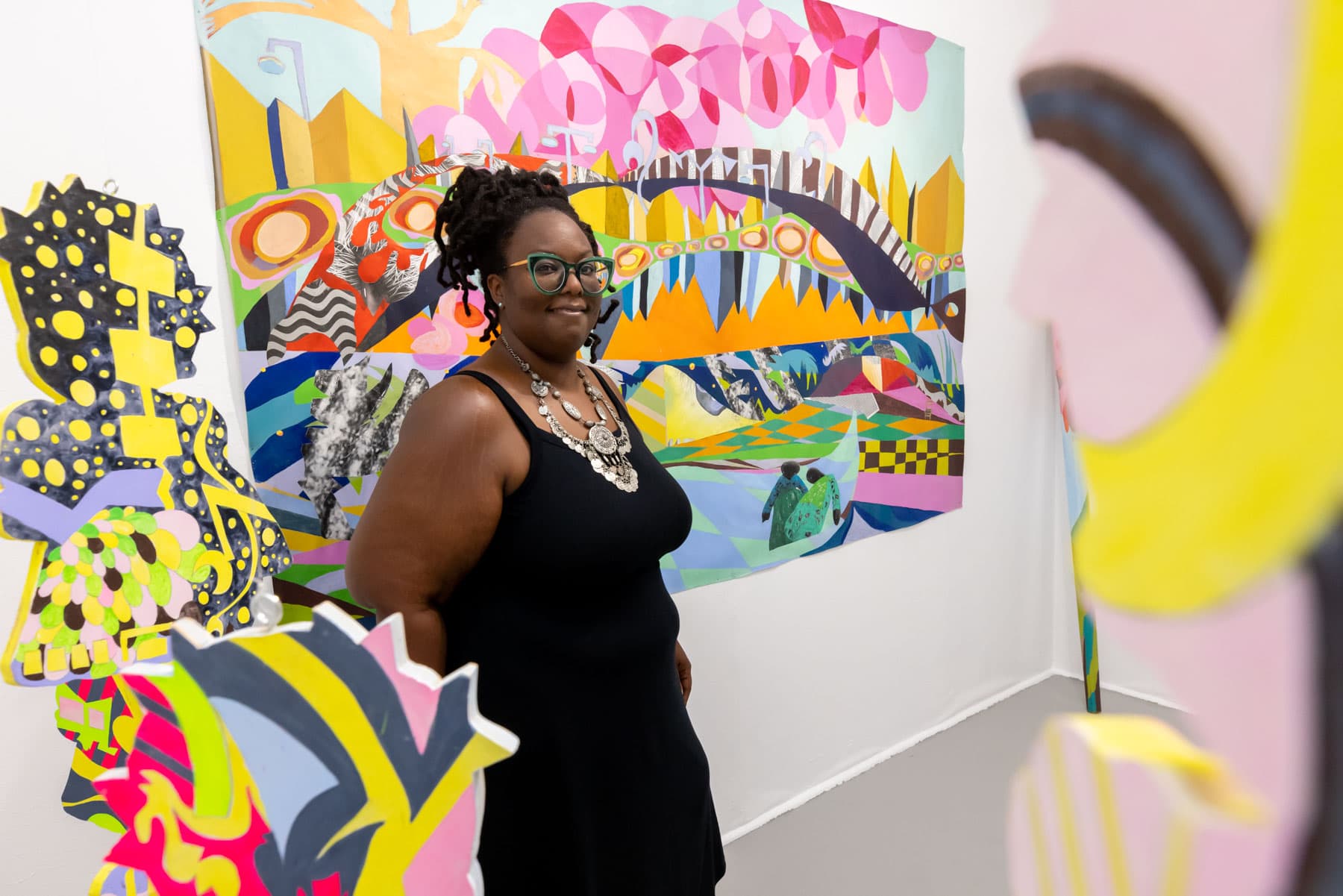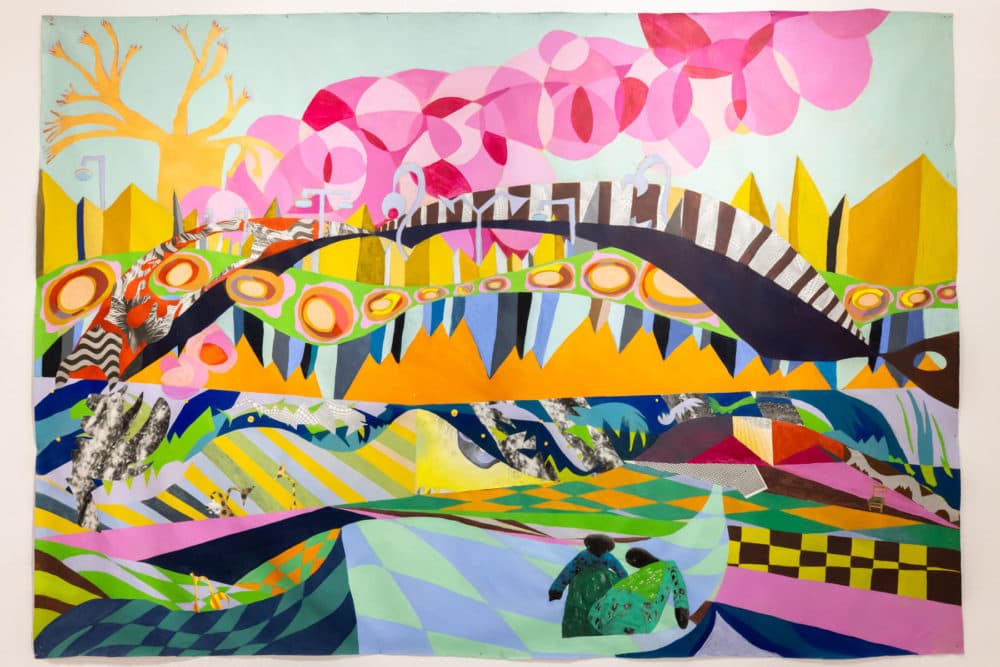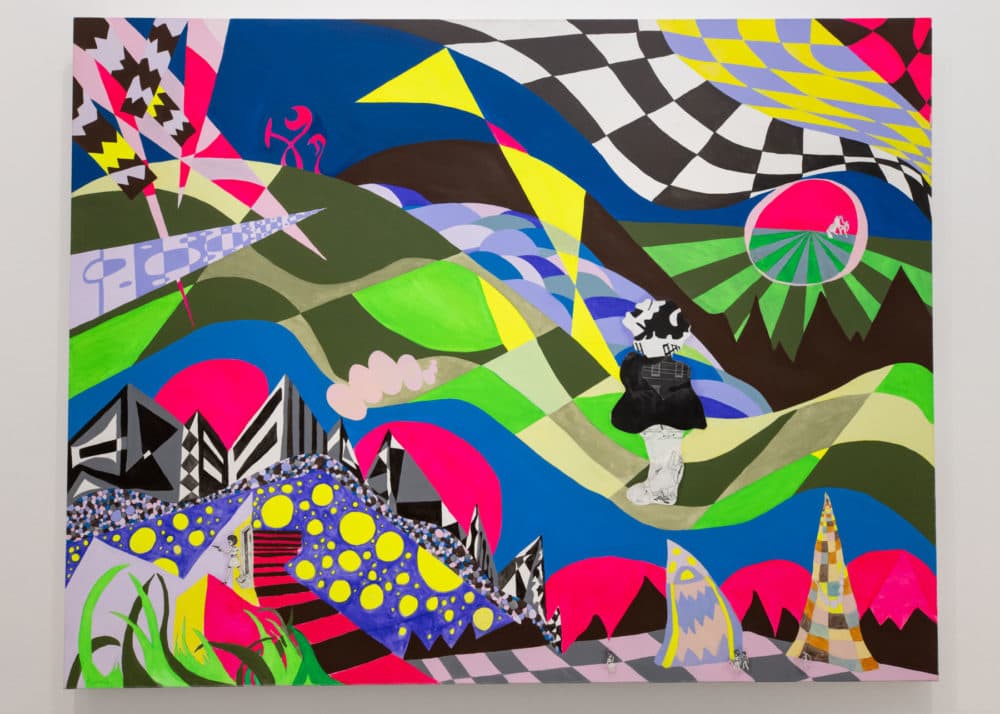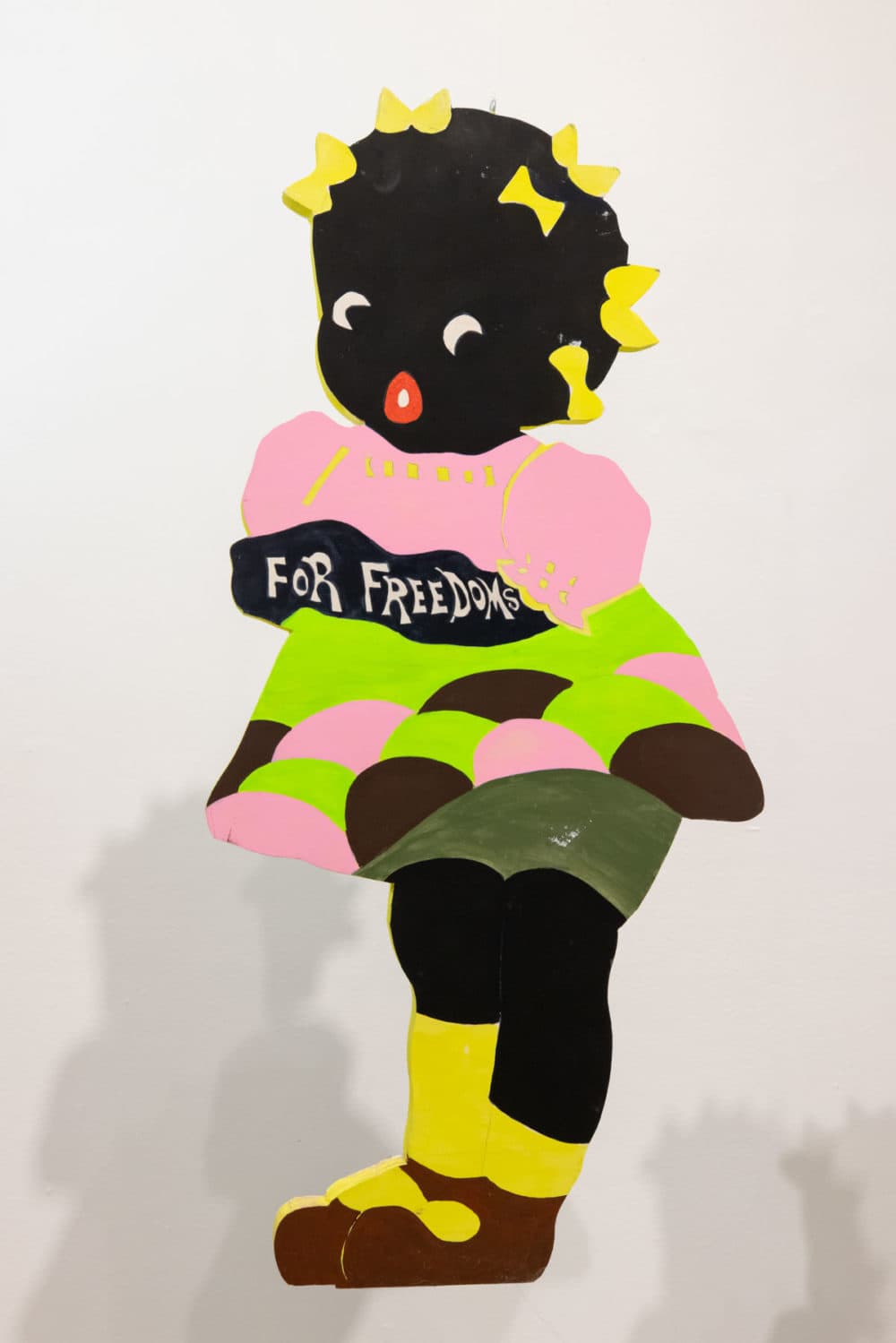Advertisement
Artist Karmimadeebora McMillan's colorful landscapes are more than what meets the eye

Regina McMillan knew her daughter would be an artist. So she chose a name people would remember: Karmimadeebora. And her mother was right. McMillan, now 45, has worked professionally as an artist for 25 years. At the moment, she is the first to show her work at the Boston Center for the Arts’ (BCA) new Project Room. Her work focuses on Black material culture, and it began when her friend gifted her a caricature from the Old South: a pickaninny. For many years, she was unsure what to do with it, but now, the doll is the ethos of much of her work.
At the BCA, the doll, whom McMillan has named Miss Merri Mack, is painted into colorful, almost psychedelic settings. She walks on bright trails of green and yellow, surrounded by shapes. “I like to think of my work as ‘Alice in Wonderland’ meets Sun Ra’s ‘Space Is The Place,’” McMillan explained. Looking at McMillan’s work on canvas is like cloud watching. If you look long enough, the shapes can be anything: skyscrapers, mountains, billows of smoke and seaweed. But it’s a trick. Her work is reminiscent of assemblage art, works of found objects put together. If you get caught up in all of the shapes and colors, you could miss what McMillan is really saying. You have to look closely to see the coded messages, many of which are a reframing of Black history.

McMillan grew up in North Carolina and was accustomed to seeing racist objects growing up. For many years across the South, objects like lawn jockeys and pickaninny ceramics were used as kitschy lawn ornaments. “When you saw something like that, you were really on high alert because that means not only are they cool with it, their neighbors are too,” said McMillan. “You were not welcome in that neighborhood.” So, when McMillan’s colleague Erin Sotak was approached while working in a gallery space by a patron who said, “I found this thing in my grandmother’s garage. I wanted to burn it,” and proposed to bring it in, McMillan wasn’t sure what to think.
She had only seen objects like the one the patron surrendered from afar: dolls and ceramics with swollen faces, exaggerated eyes and large mouths used to mock and intimidate. When Erin Sotak offered her the doll, she decided to keep it. She wasn’t sure what to think of it. But one night, after having a dream about the doll, she realized there was nothing wrong with it. The caricature has a negative connotation, “But actually,” McMillan thought, “she was pretty cute.” She liked the doll’s hair, nice dark skin and fun dress. Objects don’t inherently have meaning, rather, they’re assigned. The artist’s realization made her want to research.

Much of McMillan’s work relies on archival study, which she began doing early in her career at the McColl Center, an arts organization in Charlotte, North Carolina. Along with other artists in residency, she would travel to a junkyard on the outskirts of town. “The owner had all the Black memorabilia, like barrels of things like Mammie salt and pepper shakers,” she said. McMillan would take them back to the studio and draw them. Since graduate school at The School of the Museum of Fine Arts at Tufts, she has pulled from old books and found objects to inform her work, assessing and exploring race in our country. If you look closely at her larger installations, you’ll see coloring book figures pulled from the “Black Panther Coloring Book,” created by COINTELPRO, a project of the FBI, to scare the American public. A book once filled with images depicting falsehoods and offensive images becomes emphatic in this new context. “I’m taking what was used against us and telling it from our point of view,” said McMillan.
The artist’s research even gave birth to the name of the doll depicted in many of her paintings, Ms. Merri Mack, after learning the theory that the famous nursery rhyme originated on plantations and was sung by enslaved children. The tune, which goes like this: “Miss Mary Mack, Mack, Mack, all dressed in black,” is typically assumed to be about a woman. However, it’s likely that it was about a union ship that fought Confederate forces during the civil war. The silver buttons which you hear in the song are actually the rivets on the boat. Suitably, the first project McMillan undertook with inspiration from the doll was “Ms. Merri Mack’s First Journey.”
“Essentially, she is me, I am her and we are on this crazy art journey together—while we’re trying to break boundaries and stereotypes, we also remember.”
Karmimadeebora McMillan
The artist explained, “Essentially, she is me, I am her and we are on this crazy art journey together—while we’re trying to break boundaries and stereotypes, we also remember.” The front of Ms. Merri Mack's recreations on wood cutouts have doll-like characteristics, but various scenes dance across their backs. “Sometimes that image is talking about everyday Black American life. Sometimes it’s just abstract. It sometimes is empowering young Black girls, which is my ultimate goal by having her around anyway,” said McMillan. The artist wants to change the stereotype of the doll, to take her power back and reclaim her. “She’s only a pickaninny if that’s what you call her, and she’s only a pickaninny if that’s what you claim.”

The artist also paints rag dolls, a form of folk art that was popular within Black cultures across the South. Friends and family send them to her from yard sales and thrift shops, which she works into paintings. Sometimes, they watch over Ms. Merri Mack, and other times, they’re painted into their own colorful landscapes with their heads turned down.
Throughout the years, McMillan has heard that the bright colors in her work are a lure. “People are so mesmerized by the color. What they don’t realize is what it’s all about is color,” she said. It’s also about first judgments. The feeling you get when you see McMillan’s work is not always the same one you walk away with.
Karmimadeebora McMillan’s work is on display in the Project Room at the BCA through Sept. 10 and at the MassArt x SoWa Gallery through Sept. 25. She has been at work on a mural, to be unveiled in Roxbury on Sept. 12.
